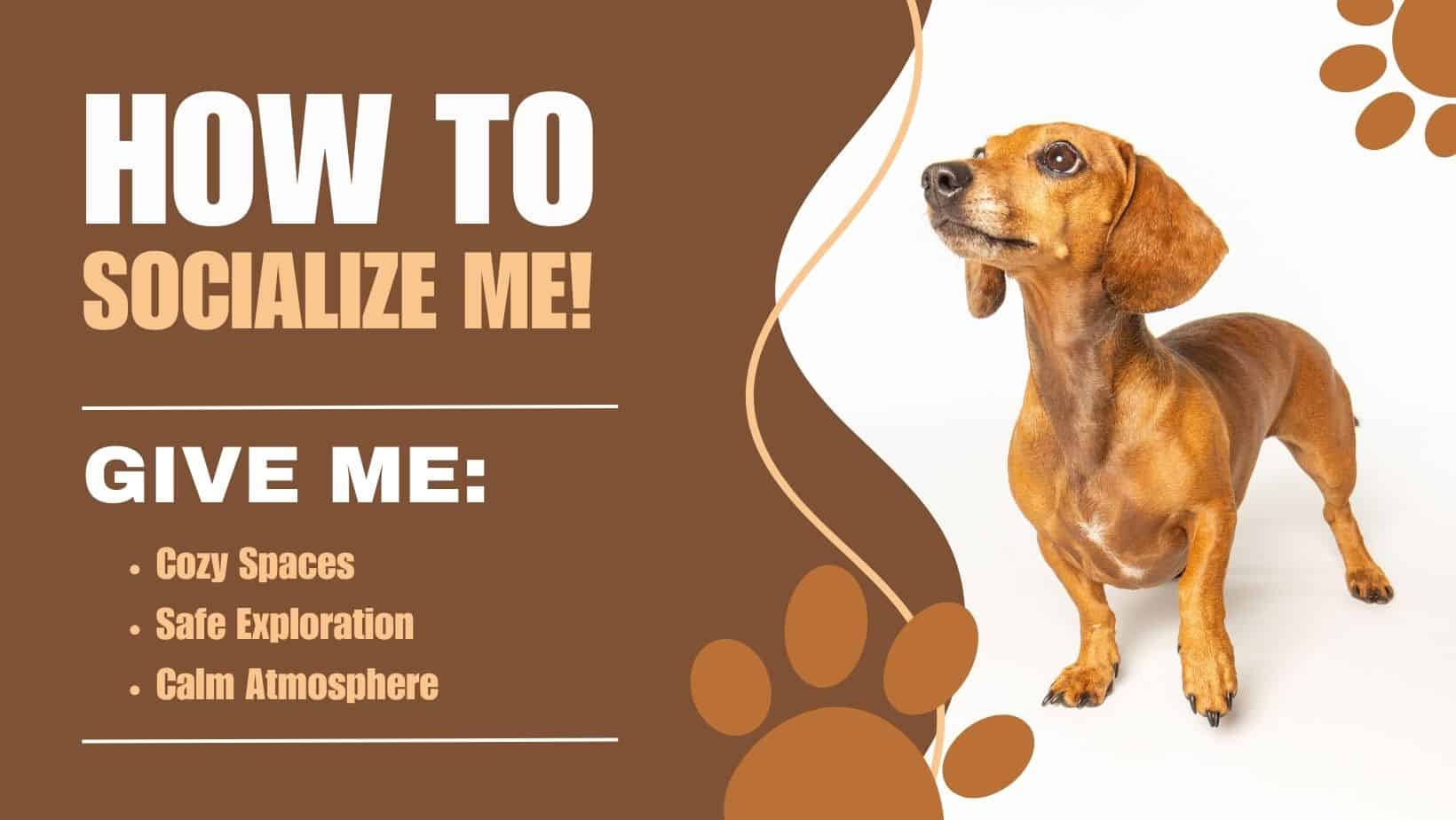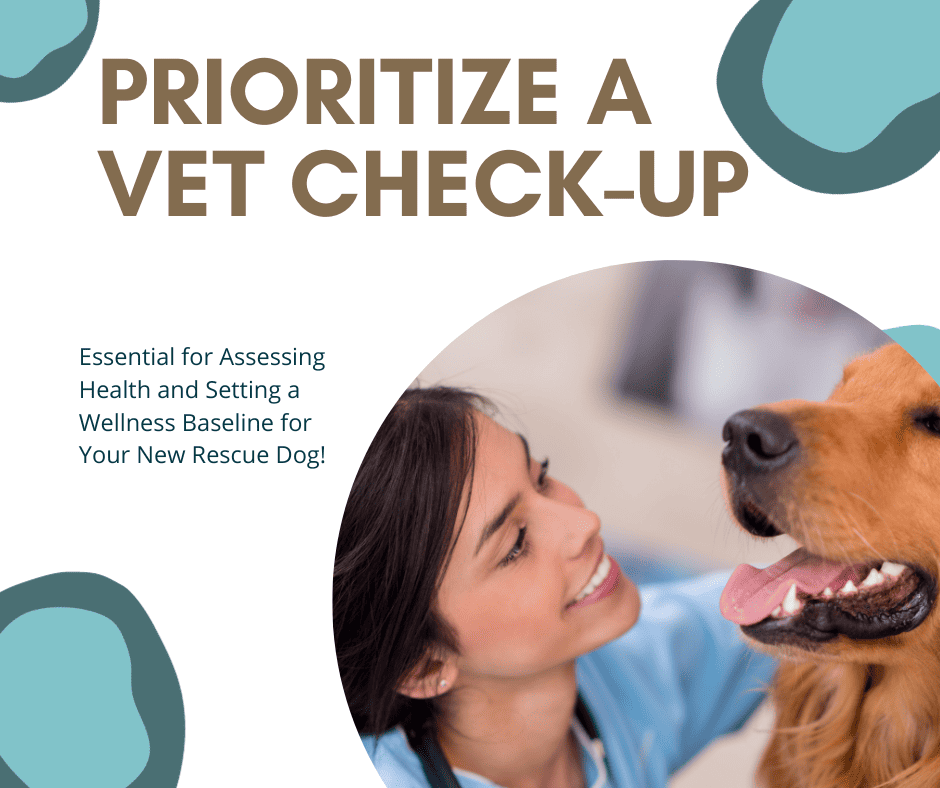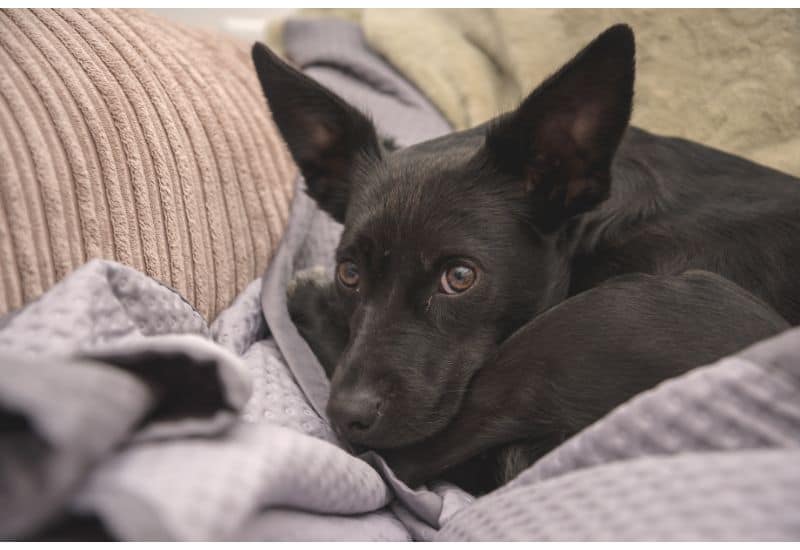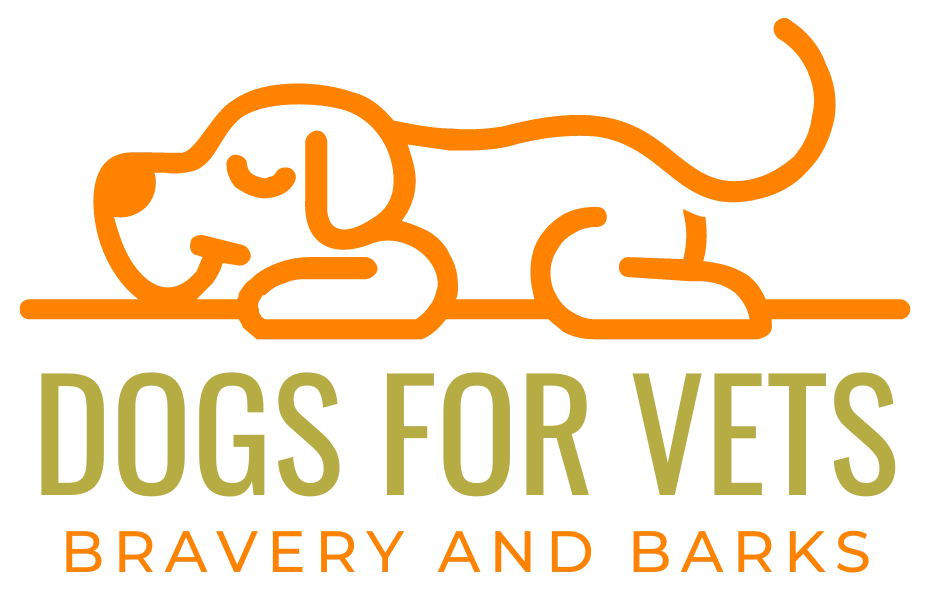This post may contain ads and affiliate links and we may earn a small commission when you click on the links at no additional cost to you. As an Amazon Affiliate, we earn from qualifying purchases. You can read our full disclaimer here.
How to Socialize a Rescue Dog: Secrets to a Well-Adjusted Pup

“How to socialize a rescue dog” – this question often lingers in the minds of new rescue dog owners.
Welcoming a rescue dog into your home is not just a generous act, but a journey filled with learning and love. Many of these dogs come from backgrounds where they may not have had the best start in life, making socialization a key step in their integration into a new, happier life.
In this guide, we’ll explore practical and compassionate ways to help your rescue dog become more comfortable and confident in their new world.
From understanding their past to building a future together, this journey can be incredibly rewarding for both you and your new furry friend.
Understanding the Background of Rescue Dogs to Understand How to Socialize a Rescue Dog
Common Experiences of Rescue Dogs
Rescue dogs often have a tapestry of past experiences, some of which might not be very pleasant. A significant number of these dogs come from environments where they faced challenges like lack of socialization, past trauma, or even neglect.
Understanding these experiences is crucial to helping them adjust.
- Lack of Socialization: Many rescue dogs might not have had the chance to interact with different people, animals, or environments. This can make new experiences overwhelming for them.
- Past Trauma: Trauma can come from abuse, abandonment, or even accidents. Such experiences can leave a lasting impact on a dog’s behavior and personality.
- Neglect: Neglect can manifest in various forms, from inadequate nutrition and healthcare to lack of emotional bonding and stimulation. This can affect a dog’s physical and psychological health.
Impact on Behavior and Socialization Needs
The background of rescue dogs significantly shapes their behavior and socialization needs. For example, a dog with a history of neglect might be more timid or anxious, requiring a gentler approach to socialization.
On the other hand, a dog that has experienced trauma might show signs of fear or aggression as a defense mechanism.
- Trust Issues: A common issue with rescue dogs is difficulty in trusting new people. They might be wary or scared, taking longer to warm up to their new family.
- Social Cues: Due to their past, some rescue dogs may not understand or respond to social cues from people or other animals, making interactions challenging.
- Behavioral Challenges: Unaddressed past traumas can lead to behavioral challenges like excessive barking, chewing, or even aggression.
Recognizing these factors is the first step towards effectively socializing a rescue dog. It sets the stage for a journey of patience, understanding, and compassionate training. Every rescue dog is unique, and their path to becoming a social butterfly is a personal one.
First Steps After Adopting a Rescue Dog: Creating the Foundation for Socialization
How to Socialize a Rescue Dog and Create a Safe and Welcoming Environment

The initial phase of learning how to socialize a rescue dog starts right in your home. It’s essential to create an environment that feels safe and welcoming for your new companion.
- Cozy Spaces: Designate a comfortable area for your dog with a bed, toys, and water. This personal space provides them with a sense of security.
- Safe Exploration: Allow your dog to explore their new home at their own pace. Keep potentially scary items like vacuum cleaners or loud electronics out of sight initially.
- Calm Atmosphere: Maintain a calm and quiet environment. Loud noises or too many people can be overwhelming for a rescue dog adjusting to their new surroundings.
Establishing a Routine
Consistency is key in helping your rescue dog adapt. A predictable routine offers stability and comfort, crucial elements in the socialization process.
- Feeding Schedule: Regular feeding times help create structure and reliability in your dog’s day.
- Walks and Exercise: Scheduled walks not only help with physical health but also provide mental stimulation and opportunities for gradual socialization.
- Consistent Commands: Use the same words for commands to help your dog understand and trust your communication.
Initial Vet Visit

An early visit to the vet is a must for addressing any health concerns and establishing a health baseline for your rescue dog.
- Health Check-Up: Ensure your dog is in good health or receive treatment for any existing issues.
- Vaccinations: Up-to-date vaccinations are vital, especially if you plan to introduce your dog to other animals.
- Discuss Behavior: Use this opportunity to discuss any observed behavioral issues with the vet. They can provide advice or refer you to a behaviorist if needed.
These first steps lay a strong foundation for your journey in socializing your rescue dog, ensuring they feel secure, understood, and ready to gradually embrace their new world.
Building Trust: A Key Step in Learning How to Socialize a Rescue Dog
Trust is the cornerstone in the journey of socializing a rescue dog. It’s about creating a bond where your dog feels safe and understood. This trust-building process is gradual and requires consistent, gentle effort from your side.
Let’s explore some effective ways to build this essential foundation.
Patience and Consistency: The Pace of Trust
Understanding and respecting your rescue dog’s pace is crucial in building trust. Every dog is different, and their past experiences will shape how quickly they adjust to their new environment and family.
Consistent behavior from you as an owner is vital. It helps your dog understand what to expect and that they are in a safe space.
- Individual Pace: Recognize that some dogs may take longer to trust and adjust.
- Consistent Behavior: Maintain a regular routine and consistent responses to help your dog feel secure.
Techniques for Building Trust: Gentle and Positive Approaches

Introducing positive reinforcement and a gentle approach can significantly aid in building trust with your rescue dog. These techniques should be aimed at making your dog feel loved and secure in your presence.
- Positive Reinforcement: Use treats and praises to encourage your dog and create positive associations.
- Gentle Interaction: Approach your dog calmly and without pressure, allowing them to initiate contact when they’re comfortable.
- Respect Their Space: Pay attention to your dog’s comfort levels and give them space when needed.
Creating a Strong Bond: Time and Understanding
Spending quality time with your rescue dog is not just enjoyable but crucial for building a lasting bond.
This time together helps you understand your dog’s unique personality and needs, further enhancing the trust between you.
- Quality Time: Engage in activities your dog enjoys, from playtime to quiet companionship.
- Understand Their Language: Learn to read your dog’s body language and vocal cues to better respond to their needs.
- Routine Care: Regular feeding, grooming, and walks establish a comforting routine and deepen your connection.
Building trust is an integral part of learning how to socialize a rescue dog. It sets a foundation for your dog to feel secure, loved, and ready to explore new social experiences with confidence.
Socializing Rescue Dogs with People and Other Animals: Practical Techniques
When considering how to socialize a rescue dog, introducing them to new people and other animals is a critical aspect. This process should be gradual, ensuring the dog feels as comfortable as possible.
The goal is to expand their comfort zone at a pace that suits them, making each new encounter a positive experience.
Gradual Introduction to New People and Animals
The key to successful socialization is to take it slow. Sudden or too frequent introductions can overwhelm your rescue dog.
It’s important to start with controlled, brief interactions and gradually increase the exposure as your dog becomes more comfortable.
- Controlled Environments: Begin introductions in a quiet, familiar environment where your dog feels safe.
- Short and Positive Interactions: Keep initial meetings brief and ensure they end on a positive note, with treats or praise.
- Regular Exposure: Gradually increase the frequency and variety of social encounters as your dog grows more confident.
Positive Reinforcement in Socialization
Positive reinforcement is a powerful tool in socializing rescue dogs. It involves rewarding your dog for desirable behaviors during social interactions, reinforcing their confidence and comfort in these settings.
- Treats and Praise: Reward your dog with treats and verbal praise when they react calmly or show interest in social interactions.
- Associating Socialization with Positives: Create positive associations with new people and animals, making socialization something your dog looks forward to.
Handling Social Cues and Boundaries
A significant part of socializing rescue dogs is teaching them to understand and respect social cues from both humans and other animals. This understanding helps prevent misunderstandings and promotes harmonious interactions.
- Reading Body Language: Help your dog learn to read and respond appropriately to the body language of people and animals.
- Teaching Boundaries: Encourage respectful behavior, like not jumping on people or respecting the space of other animals.
Socializing a rescue dog with people and other animals is a journey that requires patience, understanding, and consistency.
By following these techniques, you can help your rescue dog develop into a well-adjusted and sociable companion.
Managing Fear and Anxiety in Social Settings: A Guide for Rescue Dog Owners

Understanding how to socialize a rescue dog often involves navigating their fear and anxiety, especially in new social settings.
It’s important to recognize the signs of discomfort in your dog and know how to effectively manage these situations. By doing so, you can help your dog gradually become more confident and comfortable in social interactions.
Identifying Signs of Fear and Anxiety
The first step in managing your dog’s fear and anxiety is to recognize when they are feeling this way. Dogs communicate discomfort in various ways, and it’s crucial to be aware of these signs.
- Body Language: Look for signs like tucked tails, lowered heads, or ears pinned back.
- Vocalizations: Whining, growling, or barking can indicate discomfort or fear.
- Avoidance Behaviors: Notice if your dog is trying to escape the situation or is reluctant to interact.
Strategies to Calm and Reassure Your Dog
Once you identify that your dog is feeling anxious or scared, there are several strategies you can use to help calm and reassure them.
- Stay Calm and Supportive: Your dog can pick up on your emotions, so it’s important to stay calm and provide reassuring verbal cues.
- Remove from Overwhelming Situations: If a situation is too stressful, it’s okay to remove your dog and try again later.
- Create Positive Associations: Use treats and praise to create positive experiences in situations that previously caused fear.
Knowing When to Step Back
It’s essential to recognize when your dog has had enough and needs a break from socializing. Forcing interactions can lead to negative experiences and set back your progress.
- Respect Their Limits: Pay attention to your dog’s signals and give them space when needed.
- Gradual Exposure: Reintroduce challenging situations slowly and in a more controlled manner.
- Avoid Punishment: Never punish your dog for showing fear or anxiety, as this can exacerbate the problem.
Navigating fear and anxiety is a vital part of learning how to socialize a rescue dog. With patience, understanding, and the right approach, you can help your dog overcome their fears and enjoy social interactions.
Effective Training Tips and Exercises for Socializing Rescue Dogs
Training is an integral component in the journey of how to socialize a rescue dog. It’s not just about teaching commands, but also about helping your dog to understand and navigate the social world around them.
Effective training can significantly enhance a dog’s ability to interact confidently and comfortably in various settings.
Basic Obedience Training: The Foundation
Starting with basic obedience training lays a solid foundation for further socialization. It helps establish a line of communication between you and your dog and builds mutual respect and understanding.
- Essential Commands: Focus on basic commands like ‘sit’, ‘stay’, ‘come’, and ‘leave it’. These commands can also be useful in social situations.
- Positive Reinforcement: Use treats, praise, and affection as rewards for following commands. This reinforces good behavior and makes learning a positive experience.
- Consistency is Key: Be consistent with your commands and training sessions. Consistency helps your dog understand what is expected of them.
Social Skills Through Play and Interaction
Incorporating play and interactive activities into your training routine is a fun and effective way to enhance your dog’s social skills.
- Structured Playtime: Engage in play that involves rules and structure, like fetch or tug-of-war. This teaches your dog to follow guidelines while interacting.
- Interactive Games: Games that require interaction with other dogs or people can be beneficial. Ensure these interactions are monitored and positive.
- Social Walks: Walks where your dog encounters other dogs and people are great for practicing social skills in a controlled manner.
Behavioral Challenges: Addressing and Correcting
Sometimes, rescue dogs may exhibit challenging behaviors due to their past experiences. Addressing these behaviors is crucial for their overall social development.
- Identify Triggers: Understand what triggers your dog’s negative behavior. Is it a certain type of person, animal, or situation?
- Gradual Desensitization: Slowly and gently expose your dog to their triggers in a controlled environment, using positive reinforcement to create new associations.
- Seek Professional Help if Needed: If certain behaviors are persistent or severe, consider consulting a professional dog trainer or behaviorist.
Training your rescue dog is a rewarding process that goes beyond teaching basic commands. It’s about guiding them to be more adaptable, confident, and happy in their social interactions.
Remember, patience and understanding are key in this journey.
Common Mistakes to Avoid When Socializing Rescue Dogs
Socializing a rescue dog is a delicate process, and it’s easy to inadvertently make mistakes.
Being aware of these common pitfalls can help you navigate the path of how to socialize a rescue dog more effectively and ensure a smoother transition for your new pet.
Overwhelming the Dog with Too Much, Too Soon
One of the most common mistakes is trying to expose your rescue dog to too many new experiences too quickly. This can lead to increased anxiety and fear.
- Avoid Crowded Places Initially: Start with quiet, less crowded environments before gradually moving to busier places.
- Limit Initial Interactions: Keep initial interactions with people and other animals brief and controlled.
- Monitor Your Dog’s Reactions: Pay close attention to how your dog is handling new experiences and adjust accordingly.
Neglecting the Dog’s Individual Pace and Comfort Level
Every dog is unique, especially when it comes to their socialization needs and pace.
- Respect Their Boundaries: Pushing your dog beyond their comfort level can be counterproductive.
- Personalized Approach: Adapt your socialization techniques to suit your dog’s individual personality and past experiences.
- Patience is Key: Understand that some dogs may take longer to socialize than others.
Inconsistent or Negative Reinforcement Techniques
Consistency in training and reinforcement is crucial for a rescue dog’s learning and development.
- Consistent Commands and Rules: Changing rules or commands can confuse your dog and hinder their learning.
- Positive Reinforcement: Focus on rewarding good behavior rather than punishing negative behavior.
- Regular Training Sessions: Regular, consistent training helps reinforce learned behaviors.
Forgetting to Socialize in Different Environments
Dogs need to learn to feel comfortable in a variety of settings, not just at home or in one particular type of environment.
- Diverse Environments: Gradually introduce your dog to different places, sounds, and smells.
- Varying Experiences: Expose them to different types of people and animals in controlled settings.
- Regular Changes: Regular changes to your walking route or visiting new parks can help in this process.
By avoiding these common mistakes, you can make the process of socializing your rescue dog more effective and enjoyable for both of you. Don’t forget, the goal is to build a confident, well-adjusted dog, and this requires a thoughtful, patient approach.
Seeking Professional Help: When to Consult a Trainer or Behaviorist in Socializing Your Rescue Dog
Knowing when to seek professional help can be a crucial aspect of how to socialize a rescue dog effectively.
While many socialization and training challenges are manageable on your own, certain situations may require the expertise of a professional dog trainer or behaviorist.
Recognizing the Signs for Professional Assistance
It’s important to be aware of the signs that indicate your rescue dog might benefit from professional training or behavioral consultation.
- Persistent Fear or Aggression: If your dog consistently shows signs of fear, aggression, or anxiety that you’re unable to manage, it’s time to seek help.
- Unmanageable Behavioral Issues: Behaviors like extreme separation anxiety, incessant barking, or destructive behaviors can often be best addressed by a professional.
- Lack of Progress in Training: If you find that your efforts at training and socialization are not making progress, a professional might offer new strategies and insights.
Benefits of Working with a Dog Trainer or Behaviorist
Professional trainers and behaviorists bring a wealth of knowledge and experience to the table, which can be immensely beneficial in socializing your rescue dog.
- Customized Training Plans: Professionals can create tailored training plans that address your dog’s specific needs and challenges.
- Behavioral Insight: They can provide deeper insights into why your dog behaves in certain ways and how to effectively address those behaviors.
- Effective Techniques: Trainers and behaviorists are equipped with the latest and most effective training techniques and behavioral modification strategies.
Finding the Right Professional for Your Dog
Choosing the right professional is key to successfully addressing your dog’s socialization and behavioral challenges.
- Research and Referrals: Look for trainers or behaviorists with experience in dealing with rescue dogs. Referrals from your vet or other dog owners can be helpful.
- Check Credentials: Ensure they have the necessary qualifications and experience. Look for certifications from reputable organizations.
- Compatibility: It’s important that both you and your dog feel comfortable with the professional. Observe how they interact with your dog and their approach to training.
Seeking professional help can be a significant step in the journey of socializing a rescue dog. It not only aids in addressing specific challenges but also enhances the overall well-being and adaptability of your dog.
Seeking help is a sign of commitment to your dog’s happiness and health, not a failure on your part as an owner.
Wrap-Up to How to Socialize a Rescue Dog
Socializing a rescue dog is a journey filled with challenges, learning, and immense rewards. Remember, each dog is unique and requires a personalized approach to socialization. Patience, consistency, and understanding are key throughout this process.
Whether it’s building trust, introducing them to new experiences, managing fear and anxiety, or seeking professional help, each step you take plays a crucial role in shaping your dog into a confident and sociable companion.
As you embark on this journey with your rescue dog, keep in mind that progress may be gradual. Celebrate the small victories and remain patient through the setbacks.
The bond that you will build along the way is invaluable, and the positive impact you have on each other’s lives is immeasurable. Your efforts in learning how to socialize a rescue dog not only enhance their quality of life but also pave the way for a fulfilling and loving relationship.
Keep going, trust the process, and enjoy every moment of this rewarding journey with your four-legged friend.
-

Coffee Mug – In Dog Coffees I’ve Only Had One
Price range: $11.95 through $14.95 Select options This product has multiple variants. The options may be chosen on the product page
